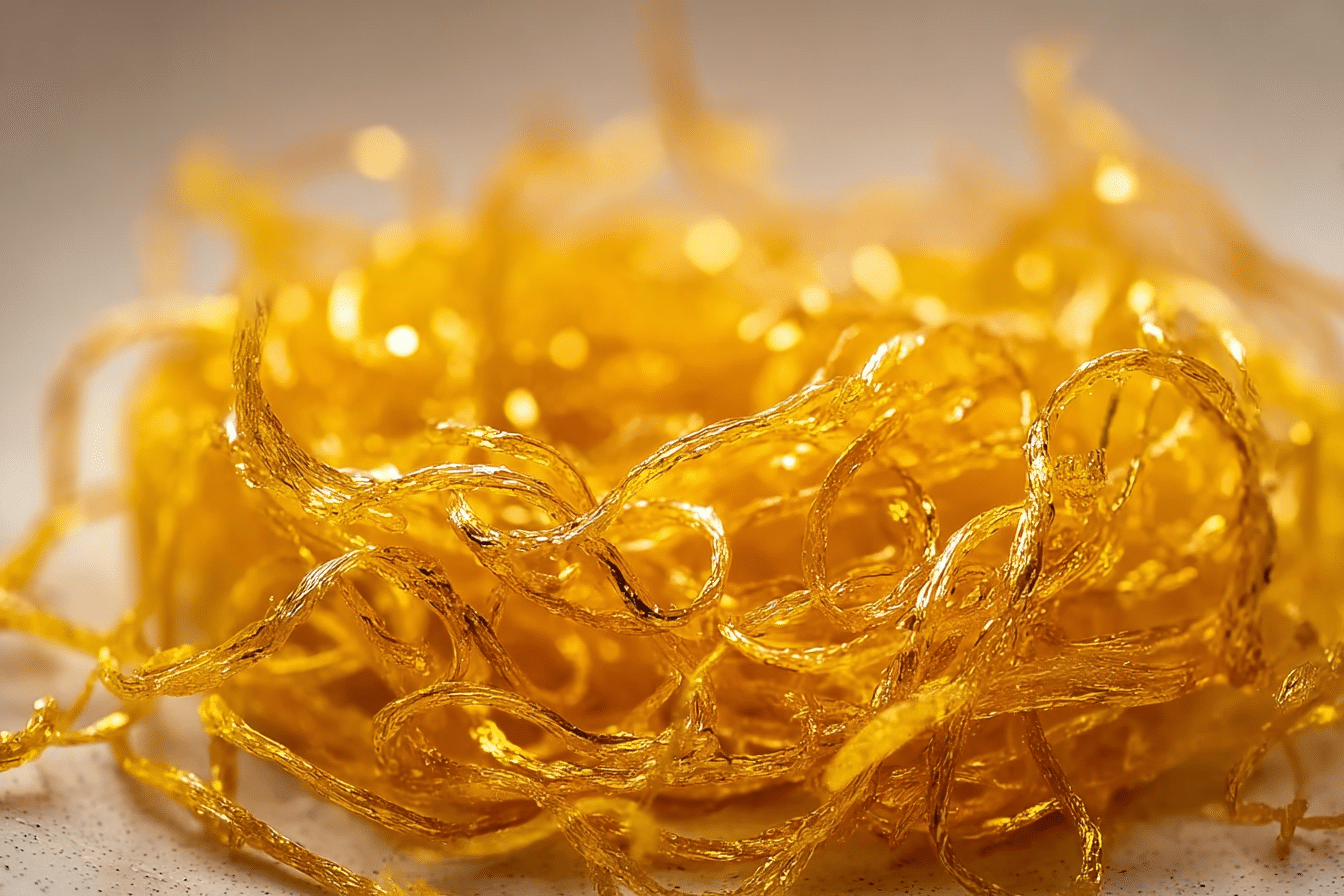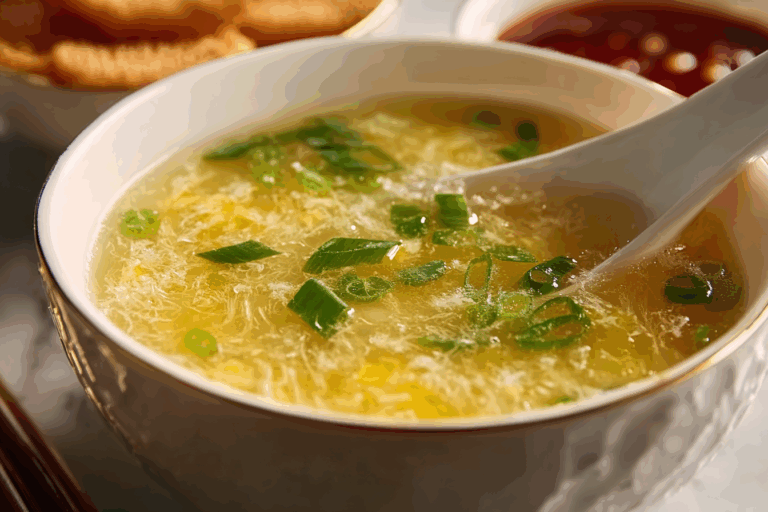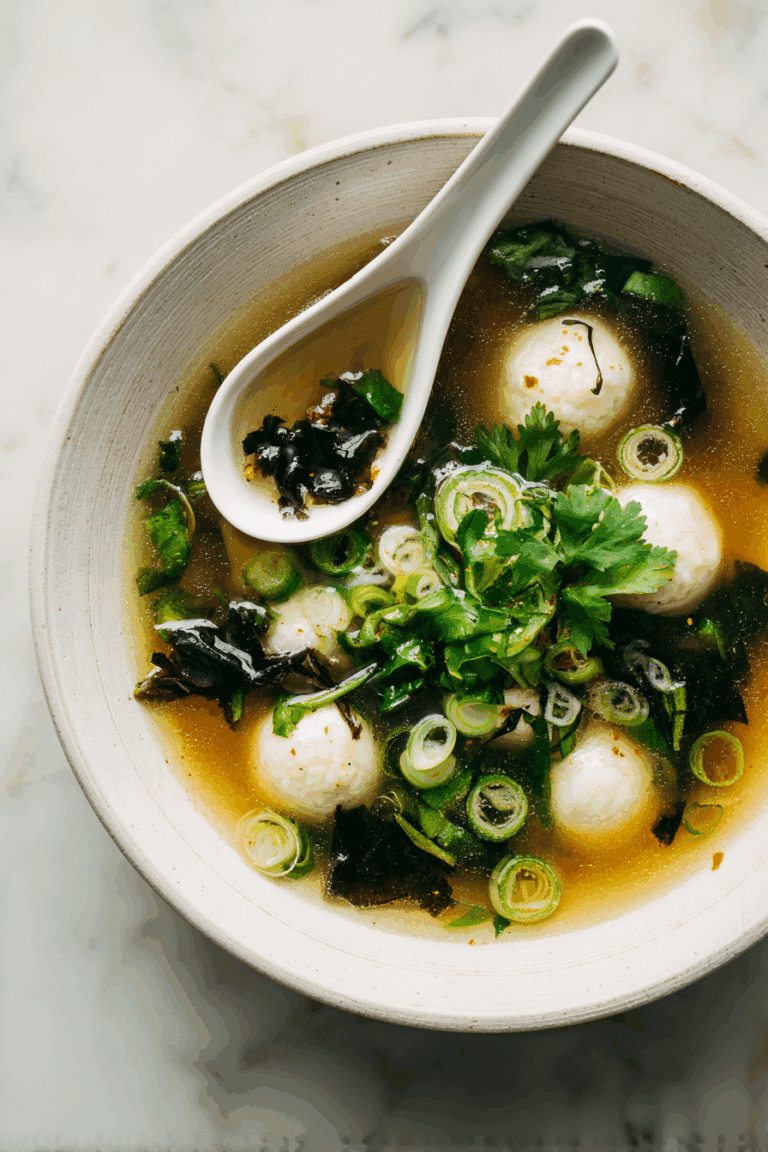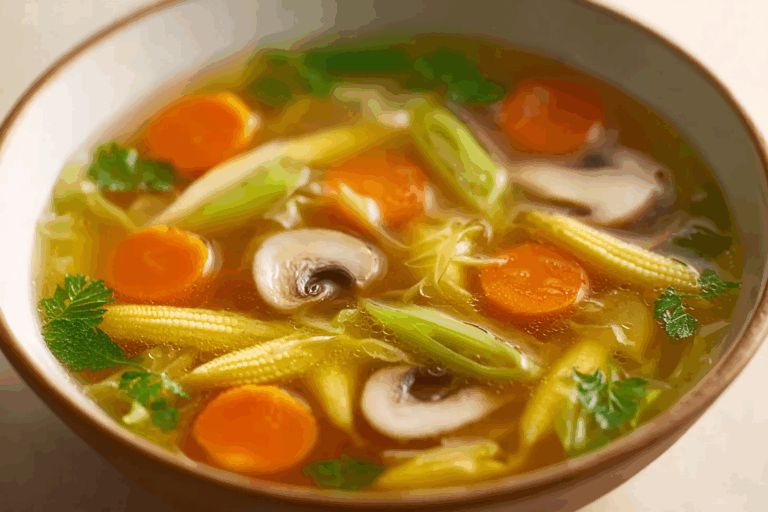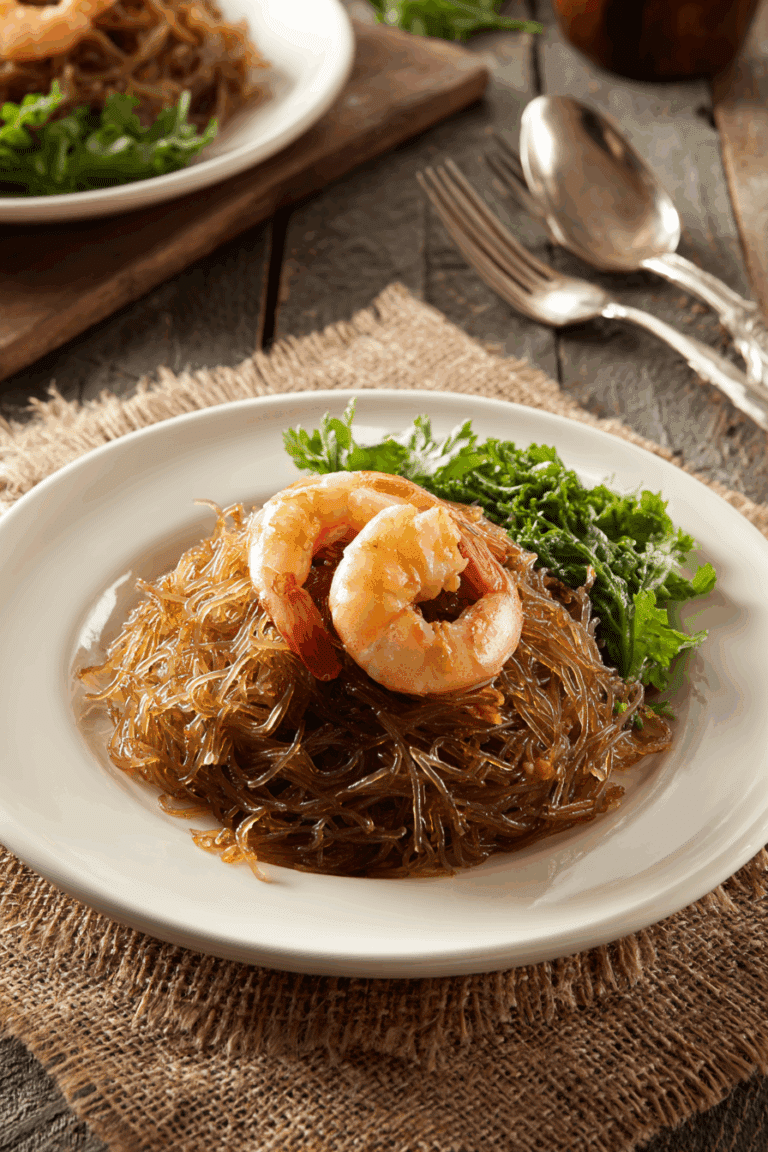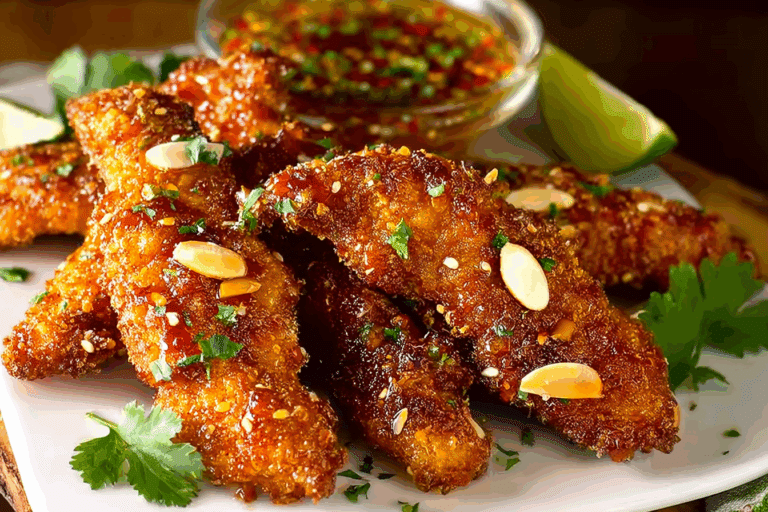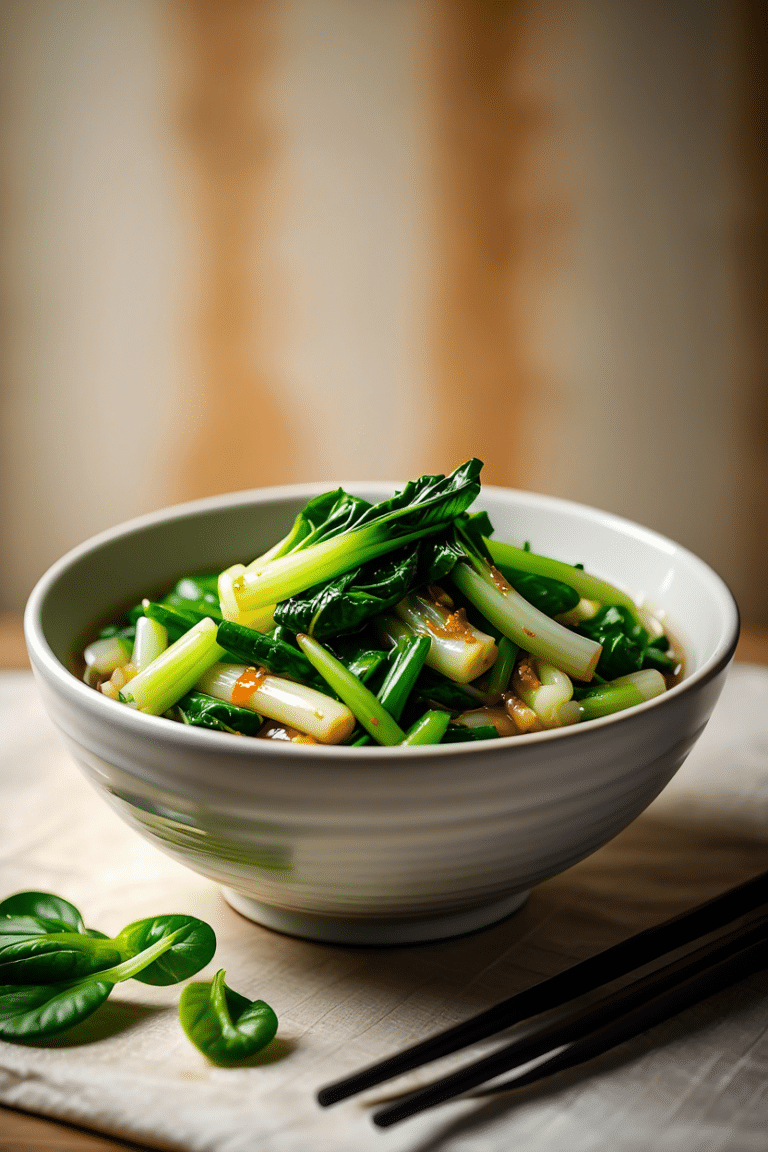Golden Egg Threads: The Sweet Obsession You Must Try
Golden Egg Threads, also known in Thailand as Foi Thong, are one of the most beloved and beautiful traditional Thai desserts. Their name alone brings to mind delicate sweetness, rich egg flavor, and glistening strands of gold that symbolize prosperity and good fortune. At Just Thai Recipes, Golden Egg Threads hold a special place in our kitchen and in our story, which began on our humble “About” page.
When we first started Just Thai Recipes, our goal was simple: to preserve authentic Thai flavors and share the joy of homemade desserts with everyone, no matter where they lived. We believe every Thai dish tells a story, and Golden Egg Threads tell one of elegance, patience, and artistry.
In this article, you will learn everything you need to know about making Golden Egg Threads at home, from preparing the perfect syrup to drizzling those thin, glossy threads with confidence. Whether you are a passionate home cook, a beginner in Thai desserts, or someone exploring Asian sweets, this recipe will guide you step by step.
You will also discover why this dish is more than just a dessert. It’s part of Thailand’s cultural heritage, often seen at weddings and festivals as a sign of eternal love and wealth. By the end of this detailed guide, you will not only know how to make Golden Egg Threads perfectly but also understand their history, variations, and cultural significance.
Table of Contents
Table of Contents
Ingredients
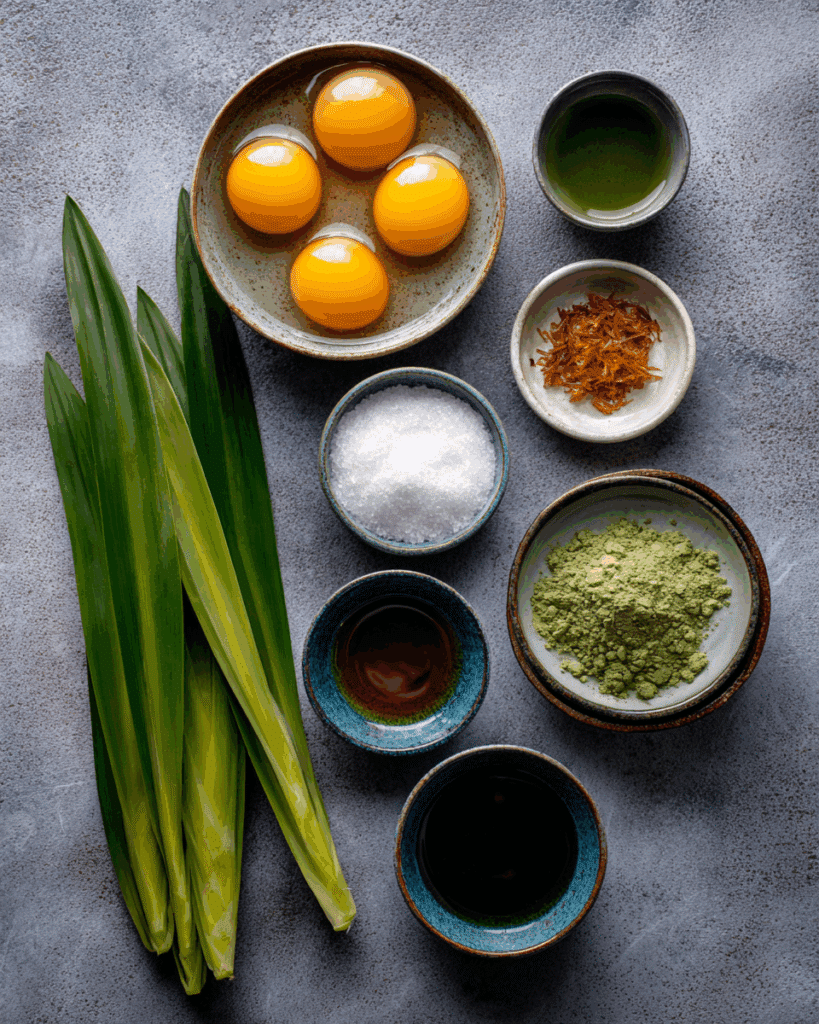
To make authentic Golden Egg Threads, you’ll need only a few ingredients, but each one plays a crucial role in creating the flavor, aroma, and golden shine that define this delicate dessert.
Ingredients List:
- 6 egg yolks
- 2 cups of water
- 1 cup of white sugar
- 1/3 of a pandan leaf, or 1/2 teaspoon pandan extract
Each ingredient in Golden Egg Threads serves a purpose. The egg yolks are the star, giving the dessert its rich yellow color and soft texture. The sugar and water form the syrup that the threads are cooked in, creating that glossy, slightly sticky finish. Pandan, a fragrant tropical plant often called the “vanilla of Southeast Asia,” adds aroma and depth.
If you don’t have access to fresh pandan leaves, you can substitute pandan extract, which is more readily available in Asian grocery stores or online. Some home cooks also like to add a drop of jasmine essence to complement the pandan’s floral notes.
Step-by-Step Instructions
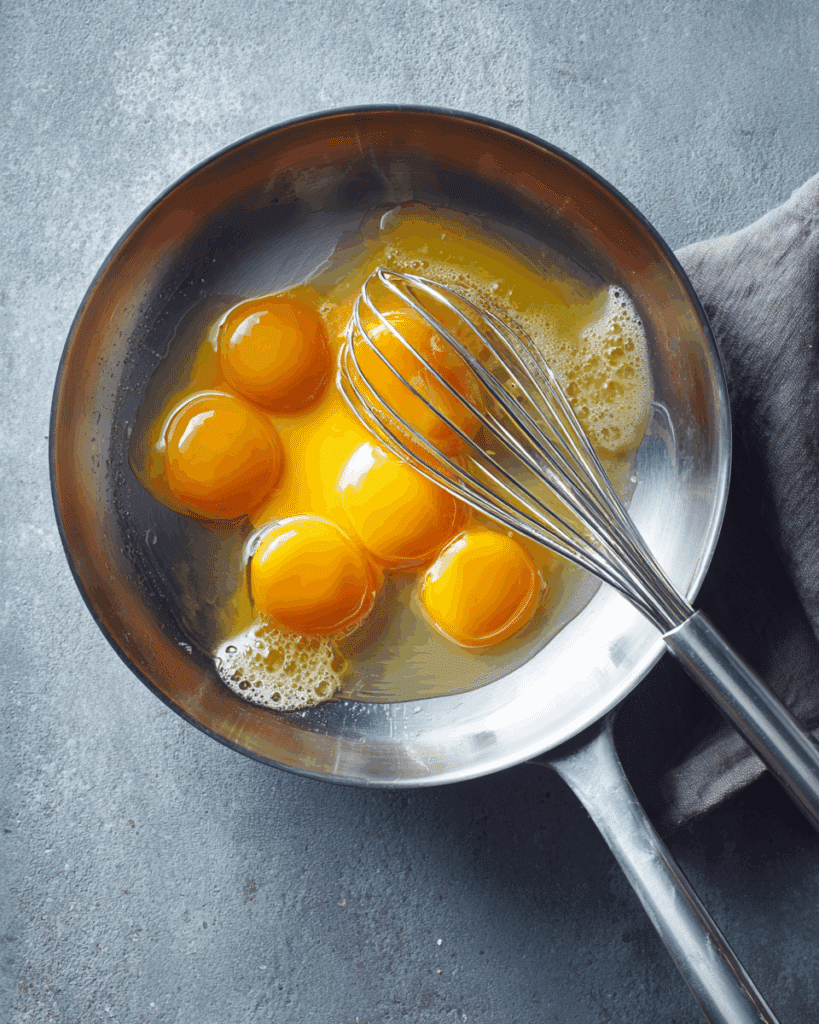
If this is your first time making Golden Egg Threads, don’t worry. The process may seem delicate, but once you understand the rhythm, it becomes meditative and satisfying. This section will take you through each step carefully.
- Prepare the Egg Yolks:
Begin by separating six egg yolks from the whites. Remove the chalazae—the small white strings attached to the yolks—and mix the yolks gently with a fork. The goal is to combine them smoothly without whipping in too much air. Air bubbles can cause uneven threads when you drizzle the yolks into the syrup. - Prepare the Syrup:
In a wide pan or shallow pot, combine 2 cups of water and 1 cup of white sugar. Bring the mixture to a boil over medium-low heat, stirring to ensure the sugar completely dissolves. Once the syrup is clear and slightly thickened, tie the pandan leaf into a knot and add it to the pot. Let it cook for about seven minutes to infuse the syrup with its fragrance. After that, remove and discard the leaf. - Prepare Your Piping Bag:
Pour the blended yolks into a small plastic Ziploc bag, pressing out as much air as possible. Twist the top of the bag to concentrate the yolks in one corner. Cut a very small tip from the corner or use a toothpick to make a hole. The smaller the hole, the thinner your Golden Egg Threads will be. - Form the Threads:
Reduce the heat to maintain a gentle simmer. Carefully drizzle the yolk mixture into the syrup, moving your hand in circles to create delicate rings. Apply steady pressure to get even strands. You can make about 7 to 10 circles per batch. - Cook the Threads:
The Golden Egg Threads will cook quickly—about 15 seconds is enough. As soon as the strands turn a deep golden color and float to the surface, use chopsticks to fold them in half, then in half again, forming a neat little bundle. - Cool and Store:
Place the folded threads on a cooling rack over a dish to drain excess syrup. Repeat until all the yolk is used. You should have around four folded bundles of bright, golden strands. These can be enjoyed cold, at room temperature, or used as a garnish on other desserts.
For visual inspiration, you can also explore this guide to Foi Thong at Lion Brand or learn egg-based dessert techniques from No Recipes.
Tips and Tricks for Perfect Golden Egg Threads
Making Golden Egg Threads takes patience, but a few small tricks will make the process easier and more rewarding.
- Control the heat: Keep your syrup at a gentle simmer, not a rolling boil. Too much heat causes the yolk to break into uneven pieces instead of forming long threads.
- Keep the bag steady: Practice your drizzle movement before you start. A smooth, circular motion creates even strands that are easier to fold later.
- Use fresh eggs: Fresh yolks have better consistency and color. Older eggs tend to create dull, brittle threads.
- Work in small batches: Don’t rush. Drizzle only a small portion of yolk at a time to keep your syrup temperature steady.
- Don’t stir the syrup: Let the threads cook undisturbed to preserve their shape.
These little habits make all the difference when creating perfect Golden Egg Threads that are silky, bright, and uniform.
Variations of Golden Egg Threads
There are several creative ways to enjoy Golden Egg Threads, and once you master the base recipe, the possibilities are endless.
- Golden Egg Threads with Coconut Cream:
Drizzle warm coconut cream over chilled threads for a richer, creamier dessert. A sprinkle of toasted sesame seeds on top adds a beautiful nutty contrast. - Golden Egg Threads with Ice Cream:
Use the threads as a topping on coconut or vanilla ice cream. The warmth of the syrup against the cold ice cream makes a delightful combination. - Layered Thai Dessert:
Combine Golden Egg Threads with sweet sticky rice and ripe mango slices for a colorful Thai dessert platter. - Gift Presentation:
In Thai culture, Golden Egg Threads are given as gifts during weddings or New Year’s celebrations. You can wrap them in banana leaves or delicate gold foil for a traditional touch.
Nutrition and Health Benefits
Golden Egg Threads are a dessert that perfectly combines beauty and nourishment. While their shimmering strands and delicate sweetness make them look indulgent, this Thai classic actually offers a surprising amount of nutrients when enjoyed in moderation. Every serving of Golden Egg Threads contains about 160 calories, with a balance of 4 grams of protein, 6 grams of fat, and roughly 20 grams of carbohydrates. These numbers may seem modest, but what truly makes this dessert special is the nutritional value hidden in the egg yolks themselves.
Egg yolks are packed with vitamins and minerals that your body needs for everyday function. They are one of the richest sources of vitamins A, D, and E, all of which are vital for maintaining healthy skin, eyes, and immunity. Vitamin D is especially important, since it helps the body absorb calcium, keeping your bones strong. The yolks in Golden Egg Threads also contain choline, which plays a key role in supporting brain health and nerve function. It’s what keeps your mind sharp and your mood balanced.
There’s also a generous amount of iron in each serving of Golden Egg Threads. Iron helps your body produce red blood cells, ensuring that oxygen travels efficiently through your system. When you think about it, you’re not just enjoying a dessert, you’re giving your body a gentle nutritional boost.
The pandan leaf or extract that’s used to flavor Golden Egg Threads adds more than just aroma. Pandan has been used in Southeast Asian cooking and herbal medicine for centuries. It’s known for helping with digestion, reducing bloating, and providing a sense of calm after a meal. The subtle fragrance from pandan can also lower stress levels, which is one reason why many people describe desserts made with pandan as comforting.
Even though Golden Egg Threads are sweet, the richness of the yolks naturally limits how much you can eat. A few silky strands are enough to satisfy a craving without overwhelming you with sugar. It’s one of those rare desserts that feel luxurious but not heavy. When served with tea or alongside fruit, it creates a balance that feels both nourishing and indulgent.
So, while you may think of Golden Egg Threads as a special treat, remember that they are also full of beneficial nutrients. That’s one reason why they’ve stood the test of time in Thai cuisine. They aren’t just beautiful to look at they offer a sense of comfort, satisfaction, and even a touch of healthful goodness in every bite.
Make-Ahead, Storage, and Freezing
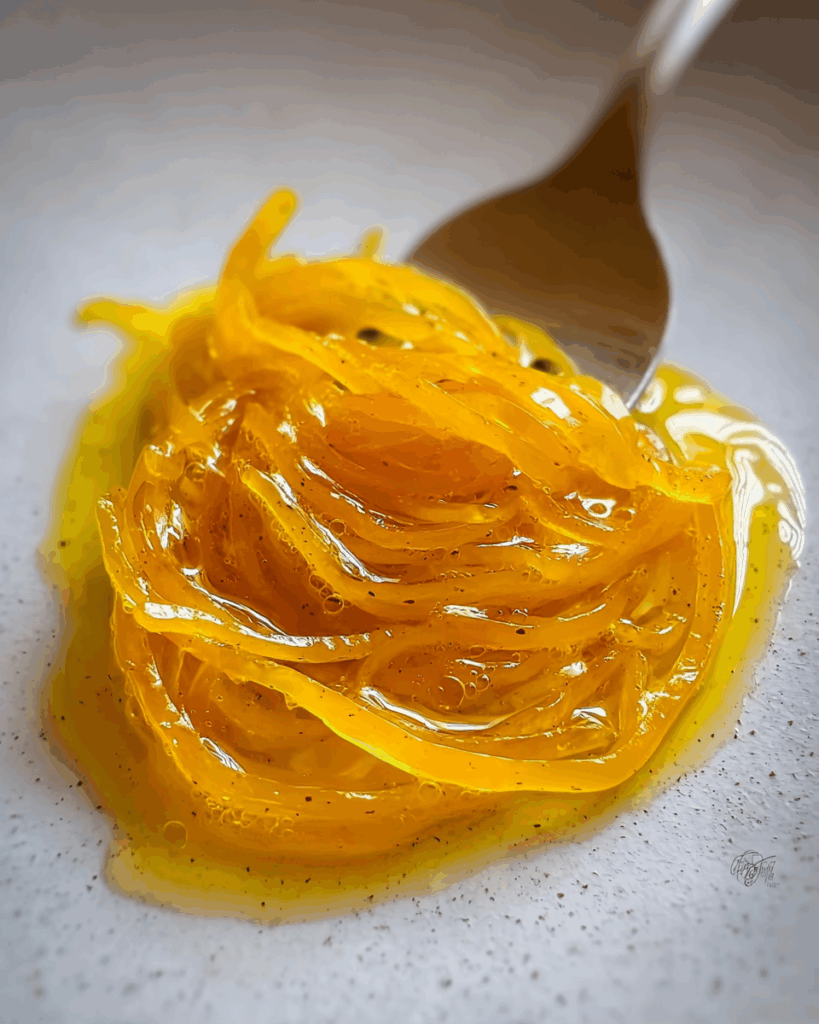
Golden Egg Threads are one of those desserts that actually get better with a little time and care. If you plan to serve them at a party, a family gathering, or even as a homemade gift, you can easily make them ahead. The key is to store them properly so they stay soft, shiny, and flavorful.
After cooking, allow your Golden Egg Threads to cool completely on a rack. Once they reach room temperature, gently transfer them to an airtight container. You can line the container with parchment paper to keep the threads from sticking together. When stored at room temperature, they stay fresh for up to 24 hours. This makes them ideal for preparing the night before an event, especially if you have many dishes to cook on the day of the celebration.
If you need to keep them longer, refrigeration is a good option. Golden Egg Threads will stay fresh in the refrigerator for about three days. However, because the cool air can make them slightly firm, it’s best to let them come back to room temperature before serving. Some Thai cooks like to lightly steam the threads for a few seconds to restore their softness and shine. Avoid reheating them directly over heat or in the microwave, as this can make the texture rubbery and take away the delicate flavor.
Freezing is also possible if you want to keep Golden Egg Threads for a longer period, such as up to a month. To freeze them properly, arrange the folded bundles between sheets of wax paper or parchment paper, then seal them in a freezer-safe container. This prevents them from sticking together or breaking apart. When you’re ready to enjoy them, take out the desired portion and allow it to thaw naturally at room temperature. You can also gently steam them for a few minutes to bring back their soft, flexible texture.
One extra tip: if you plan to use Golden Egg Threads as a garnish for other desserts, freeze them in smaller portions so you can defrost only what you need. This helps maintain their freshness and prevents unnecessary waste.
Golden Egg Threads are surprisingly resilient when stored correctly. They hold their golden color, their sweetness, and that lovely aroma of pandan. Whether you make them in advance for a festival, for a gift, or just to enjoy during the week, they’ll taste just as delightful as the day you cooked them.
Common Mistakes to Avoid
Making Golden Egg Threads is as much an art as it is a recipe. It requires a bit of focus, a gentle hand, and some patience. Even experienced cooks can make small mistakes that affect the final texture or flavor. Here are the most common errors people make, along with simple tips to help you avoid them.
1. Boiling the syrup too fast
The syrup is the heart of the recipe, and it must stay at the right temperature. If the syrup boils too hard, the egg yolks will scatter and clump together instead of forming thin, delicate strands. The key is to keep the syrup at a low, steady simmer. It should bubble gently, not aggressively. This allows the yolks to cook evenly and form smooth, golden threads that float gracefully on the surface.
2. Drizzling too quickly
Another mistake is squeezing the egg yolk mixture too fast into the syrup. This results in thick, uneven strands that cook unevenly. The trick is to apply slow, even pressure to your piping bag or Ziploc bag. Move your hand in a circular motion over the pan and take your time. The goal is to create fine, uniform threads that look like golden silk.
3. Overcooking the threads
Golden Egg Threads only need about 15 seconds to cook. If you leave them in the syrup too long, they will become dry, brittle, and lose their shine. Once they turn slightly darker and float to the surface, it’s time to lift them out. Overcooked threads can also taste slightly bitter, which ruins the delicate sweetness of the dessert.
4. Skipping the pandan leaf
Pandan may seem like a small addition, but it makes a big difference. It adds fragrance and a subtle complexity that defines authentic Thai Golden Egg Threads. Without it, the dessert can taste flat and overly sweet. Even a few drops of pandan extract can transform the flavor, making your kitchen smell like a traditional Thai bakery.
5. Using the wrong pan
A wide, shallow pan works best for making Golden Egg Threads. It allows the syrup to heat evenly and gives you enough space to move your hand in circles while drizzling the yolk. A deep pot, on the other hand, makes it difficult to control the shape of the threads and can lead to uneven cooking.
By keeping these tips in mind, you’ll find that making Golden Egg Threads becomes easier each time. The process teaches patience, precision, and a sense of flow, which are at the heart of Thai dessert making.
Cultural and Historical Background
Golden Egg Threads, or Foi Thong in Thai, are not just a dessert. They are a story woven into the cultural and historical fabric of Thailand. Their history goes back over 300 years, to a time when Portuguese influences began blending with Siamese culinary traditions.
The origin of Golden Egg Threads can be traced to the 17th century when a woman named Maria Guyomar de Pinha introduced a variety of egg-based sweets to the royal court of Ayutthaya. She was of Portuguese and Japanese descent and married to Constantine Phaulkon, a Greek adventurer who served as a minister to King Narai. Maria brought with her the Portuguese tradition of making confections from egg yolks and sugar, similar to desserts like fios de ovos. Over time, the Siamese royal cooks adapted the recipe, infused it with local ingredients like pandan, and turned it into the beautiful Thai delicacy we know today as Golden Egg Threads.
In Thailand, Golden Egg Threads have deep symbolic meaning. The golden color represents wealth, happiness, and prosperity. The long strands symbolize longevity and lasting relationships, making this dessert a popular choice at weddings and New Year celebrations. During these occasions, families often prepare or gift Golden Egg Threads as a gesture of good fortune and eternal love.
Even today, you’ll find Golden Egg Threads in Thai festivals, temple offerings, and ceremonial gifts. They are often presented in decorative boxes wrapped in gold paper or banana leaves. The act of giving Golden Egg Threads is seen as a blessing, a way to wish others success and joy in their lives.
Beyond Thailand, similar versions of this dessert exist in Japan, Brazil, and the Philippines, each carrying a touch of Portuguese heritage. Yet, the Thai version remains unique for its use of pandan and its delicate method of preparation. It’s a perfect example of how global influences can merge with local culture to create something timeless and meaningful.
Serving Suggestions
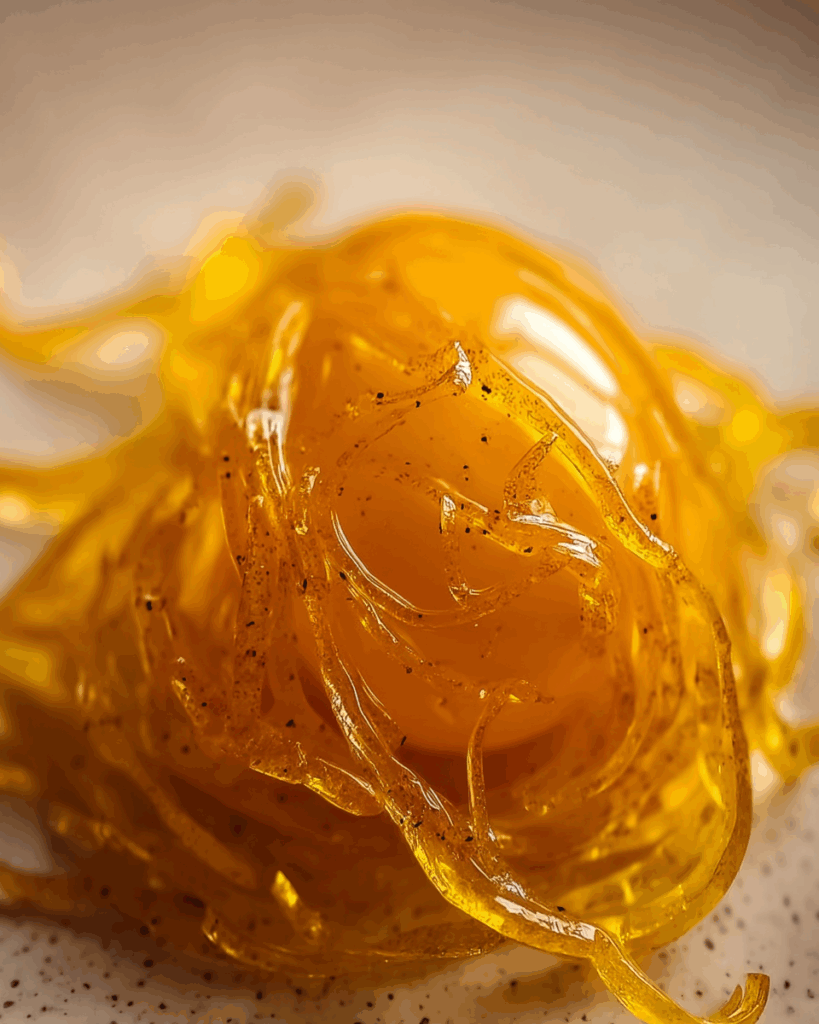
Golden Egg Threads are as versatile as they are beautiful. Their sweet, slightly eggy flavor and soft texture make them an elegant addition to many Thai and fusion desserts. Here are several creative ways to enjoy them, whether you want something traditional or modern.
1. Serve as a stand-alone dessert
Enjoy Golden Egg Threads chilled or at room temperature. Place them neatly on a small plate or in a dessert bowl, and drizzle a little syrup over them for added shine. Their golden hue looks stunning under natural light, making them perfect for festive displays.
2. Pair with traditional Thai sweets
Golden Egg Threads go wonderfully with other Thai desserts like sticky rice, coconut custard, or pandan layer cake. The combination of sweet coconut and fragrant pandan enhances the richness of the yolk, creating a perfectly balanced bite.
3. Add to Western desserts
Try using Golden Egg Threads as a topping on vanilla ice cream, crepes, or pancakes. The warm golden strands paired with cold ice cream create a unique texture that surprises and delights. You can even wrap them around a scoop of coconut sorbet for a tropical twist.
4. Combine with fresh fruits
If you prefer something light, pair Golden Egg Threads with slices of mango, banana, or pineapple. The freshness of the fruit cuts through the sweetness, making it refreshing and satisfying.
5. Make elegant gift packages
In Thai tradition, giving Golden Egg Threads is a sign of goodwill and prosperity. Wrap them in banana leaves or place them in small decorative boxes for a thoughtful homemade gift. They’re also perfect as wedding favors or New Year’s gifts for family and friends.
6. Serve with tea or coffee
A cup of Thai milk tea or jasmine tea perfectly complements the sweetness of Golden Egg Threads. The gentle bitterness of tea balances the sugary flavor, creating a calming, satisfying pairing that feels luxurious yet simple.
When people search for Golden Egg Threads, they often discover a beautiful world of similar desserts that highlight the artistry of cooking with egg yolks and sugar. In fact, one of the most interesting things about this sweet dish is how it inspires curiosity and creativity. Many home cooks who start by searching for Golden Egg Threads recipe eventually branch out to explore other related searches such as How to make egg threads, Golden egg recipe, Golden egg yolk, Shredded egg recipe, and Egg yolk sweets. Each of these searches tells a small story about how people from around the world connect through dessert-making.
The search for Golden Egg Threads recipe usually begins with curiosity. People see the dessert’s elegant golden strands and wonder how something so delicate can be made at home. They imagine the soft sweetness, the glossy finish, and that slightly chewy texture, and they want to recreate it in their own kitchens. What they discover is not just a recipe but a craft that has been passed down through generations.
Others who search How to make egg threads are often looking for techniques and precision. They want to know how to drizzle the yolk just right, how to maintain the syrup temperature, and how to avoid breaking the delicate strands. These learners value patience, and many find that making Golden Egg Threads becomes almost therapeutic — a mindful experience that slows life down.
The search Golden egg recipe may sound similar, but it can lead to many different cultural variations. Some people are drawn to the idea of using egg yolks in creative ways, from savory dishes to confections. In Thailand, the “golden egg” isn’t just a color but a symbol of wealth, purity, and renewal. Golden Egg Threads embody that symbolism, representing both beauty and skill.
Then there’s the search for Golden egg yolk and Shredded egg recipe. These usually come from those who have tasted the dessert and can’t forget it. They remember its texture, the way it melts in the mouth, and its subtle pandan aroma. They want to replicate that memory, to make something that tastes like happiness itself.
Lastly, Egg yolk sweets is a phrase that connects Golden Egg Threads with an entire family of desserts around the world from Portuguese fios de ovos to Japanese tamago sweets. It shows how one simple ingredient, when treated with care, can become a bridge between cultures. So whether someone searches for Golden Egg Threads out of curiosity, nostalgia, or the desire to master something beautiful, what they find is more than just food. They find a tradition that celebrates patience, precision, and joy.
Conclusion
There’s a special kind of satisfaction that comes from making Golden Egg Threads at home. Watching the egg yolk turn into fine, glowing strands that float on syrup feels almost magical. Each thread shines like spun gold, and every batch carries the essence of Thai tradition a blend of patience, skill, and love.
For us at Just Thai Recipes, Golden Egg Threads are more than just a dessert. They represent our connection to family, culture, and the warmth of shared meals. When we first began our culinary journey, this dessert captured our hearts because of its symbolism and simplicity. It reminds us of Thai celebrations, the smell of pandan leaves simmering in sugar syrup, and the laughter that fills the kitchen when everyone gathers around to taste the first golden batch.
Making Golden Egg Threads might seem like a delicate process, but it’s also deeply rewarding. It teaches you mindfulness how to slow down, how to move with intention, and how to appreciate every small detail. The moment you lift the glossy threads from the syrup and see them glisten in the light, you’ll understand why this dessert is so special to Thai culture.
If this is your first time making Golden Egg Threads, take your time and enjoy the process. Feel the rhythm of the drizzle, smell the sweetness of the syrup, and let yourself get lost in the art of cooking. With every strand, you’re not just making dessert you’re keeping a piece of history alive.
We hope this guide inspires you to try making Golden Egg Threads in your own kitchen. Whether you serve them as a gift, a celebratory dessert, or a simple treat after dinner, they will always bring a little bit of joy and luxury to the table. And if you enjoyed this recipe, explore more authentic Thai desserts on our site. From coconut-based sweets to fruit-filled delicacies, there’s a whole world of flavors waiting for you. Remember, sweetness always tastes better when it’s shared.
FAQ
What is the cultural significance of Golden Egg Threads in Thai traditions?
Golden Egg Threads hold deep meaning in Thai culture. Their golden color symbolizes wealth, success, and happiness, while their long, delicate strands represent longevity and everlasting love. This is why they are often served at weddings, New Year’s celebrations, and religious festivals. Offering or gifting Golden Egg Threads is considered an act of good fortune a way to wish someone prosperity and joy. Beyond symbolism, they are also a reflection of Thai artistry. The care and patience required to make each strand embody the Thai philosophy of mindfulness and respect for tradition. In every bite, you can taste both the sweetness and the story that has been passed down for generations.
Can I prepare Golden Egg Threads ahead of time for an event or special occasion?
Absolutely, yes. Golden Egg Threads are a wonderful make-ahead dessert because they keep their flavor and texture beautifully. After cooking, let them cool completely and store them in an airtight container. If you plan to serve them within 24 hours, room temperature storage works fine. For longer storage, place them in the refrigerator for up to three days, allowing them to reach room temperature before serving. You can also freeze them for up to a month, placing parchment between each folded bundle to prevent sticking. Before serving, steam them gently for a few seconds to bring back their softness and shine.
How do I make sure my Golden Egg Threads stay soft, glossy, and beautiful?
To keep Golden Egg Threads soft and shiny, temperature control is everything. The syrup should stay at a gentle simmer not too hot, not too cold. If it’s boiling too strongly, the threads will break apart and lose their shape. If it’s too cool, the yolks will sink instead of floating. Make sure you don’t overcook them, as just 15 to 20 seconds in the syrup is enough. Once they’re done, lift them carefully and place them on a rack to cool naturally. Don’t cover them while they’re still warm, or they’ll lose their shine. If stored correctly, they’ll remain soft and beautiful for days.
What are Golden Egg Threads made of, and why are they special?
Golden Egg Threads are made primarily from egg yolks, sugar, water, and fragrant pandan. The ingredients might sound simple, but the process transforms them into something extraordinary. The syrup must reach just the right consistency, and the yolks must be drizzled in thin streams to form golden strands. What makes Golden Egg Threads special is their combination of texture and meaning. They’re soft yet slightly chewy, sweet but not cloying, and they carry centuries of Thai culinary heritage. Every strand symbolizes wealth, happiness, and longevity, which is why they’re often given as gifts during weddings and festive occasions.
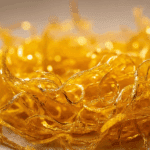
Golden Egg Threads
- Prep Time: 15 minutes
- Cook Time: 20 minutes
- Total Time: 35 minutes
- Yield: 4 servings 1x
- Category: Dessert
- Method: Simmering
- Cuisine: Thai
- Diet: Halal
Description
Golden Egg Threads, also known as Foi Thong, are a traditional Thai dessert made from delicate strands of egg yolks cooked in sweet pandan syrup. Their golden color symbolizes prosperity and love, making them a favorite treat for celebrations and gifts.
Ingredients
- 6 egg yolks
- 2 cups water
- 1 cup white sugar
- 1/3 of a whole pandan leaf, or 1/2 teaspoon pandan extract
Instructions
- Remove the chalazae, the white strings that connect to the yolks, and mix the yolks gently with a fork until smooth. Transfer the blended yolks into a small Ziploc bag, pressing out as much air as possible.
- In a wide pan or pot, combine 2 cups of water and 1 cup of white sugar. Bring to a boil over medium-low heat, stirring until the sugar completely dissolves.
- Once the syrup begins to bubble, tie the pandan leaf into a knot and add it to the pot. Let it simmer for about 7 minutes to infuse the syrup with fragrance. Remove and discard the pandan leaf afterward.
- Twist the Ziploc bag so the egg yolk mixture is concentrated in one corner. Carefully cut a very small tip off the corner or poke a tiny hole with a toothpick. Hold the bag upright to let any air bubbles escape before drizzling.
- Prepare a cooling rack with a dish underneath to catch syrup drips. Have chopsticks or skewers ready to manipulate the egg threads.
- Reduce the syrup to a gentle simmer. Drizzle the yolk mixture slowly in circles over the syrup, creating 7 to 10 rings per batch. Maintain even pressure for consistent thread thickness.
- Cook the threads for about 15 seconds until they float and turn a deeper golden color. Use chopsticks to gently fold the strands in half twice, forming a neat bundle.
- Lift each bundle carefully with chopsticks and transfer it to the cooling rack. Repeat until all the yolk is used, making about 4 folded packages depending on pot size.
- Allow the Golden Egg Threads to cool completely. Serve them cold on their own or use them as an elegant garnish for other Thai desserts.
Notes
- Keep the syrup at a gentle simmer to prevent the yolks from scattering.
- Use a wide, shallow pan for better control of thread formation.
- Do not overcook; 15 seconds is usually enough for perfect texture.
- Fresh eggs provide better color and structure for the threads.
- Store leftovers in an airtight container at room temperature for 24 hours or refrigerate for up to three days.
Nutrition
- Serving Size: 1 bundle (about 1/4 of recipe)
- Calories: 160
- Sugar: 18g
- Sodium: 15mg
- Fat: 6g
- Saturated Fat: 2g
- Unsaturated Fat: 3.5g
- Trans Fat: 0g
- Carbohydrates: 20g
- Fiber: 0g
- Protein: 4g
- Cholesterol: 220mg
Keywords: Golden Egg Threads, Foi Thong, Thai dessert, Golden Egg Threads recipe, egg yolk sweets, shredded egg recipe, how to make egg threads, golden egg recipe, golden egg yolk

